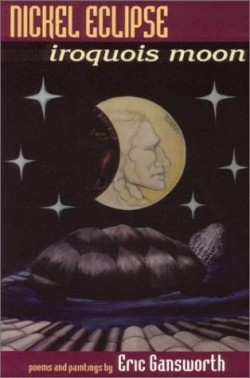Iroquois Moon
The year in Indian Country is divided into thirteen moons. Thirteen equal cycles of four weeks, twenty-eight days. The Sugar Moon, Fishing Moon, and the Very Cold Moon are examples denoting the seasons and their seasonal activities in the Iroquois calendar.
It is in this framework that Gansworth has chosen to set the structure of his book of poems. The use of the eclipse metaphor represents the waxing and waning and waxing of Indian life in these post-contact times. The eclipse also denotes the (albeit temporary) advent of Western civilization over Indian culture. An Indian world that now includes elements of that Western contact, fragments of contemporary culture, and religion indelibly wedded to the modern Indian—coffee, cigarettes, and the movies being as Indian nowadays as sage, sweetgrass, and long hair on both men and women. The Indian-head nickel is a prime example; the dominant culture’s currency emblazoned with an Indian profile and a buffalo. Things are forever and hopelessly mixed up, like a good batch of corn soup. The most Indian trait of all is to make-do with whatever is available.
Strong, full of the humorous irony that Indian life is famous for, these poems present an uncommon slice of American life. In a poem entitled “Wine and Cheese” the chasm between White and Indian is navigated. “Mike and me / two reservation boys / in a plush, carpeted living room / (some friend of his from school) / need to be told / to use coasters (having thought they were / small decorative petrified / wood pieces) / when placing the crystal / long-stemmed wine goblets / on the glass-top coffee table.”
Through these poems Indians are seen as they are now, a living, changing, vital culture. Gansworth provides Indian time and war ponies, reservation magic and witchcraft, mystery and gritty cold walks to the outhouse. In a poem subject that is deeply and personally entrenched in Indian life, “On Meeting My Father in a Bar for the First Time,” he makes something that is not at all humorous seem somehow inexplicably normal. “Sidling up to some / potentials, I nod / and smile that smile / which will buy me / at least a draft.” His words echo a familiar chorus heard before in Indian Country.
Gansworth offers an agile and fluent dance of language that keeps readers tight in the drum’s circle. Meanwhile he debunks the mystical realm some well-meaning white people would like to relegate Indians to, “I don’t know any Indians / who wear crystals / around their necks.”
Reviewed by
Gabrielle Shaw
Disclosure: This article is not an endorsement, but a review. The publisher of this book provided free copies of the book to have their book reviewed by a professional reviewer. No fee was paid by the publisher for this review. Foreword Reviews only recommends books that we love. Foreword Magazine, Inc. is disclosing this in accordance with the Federal Trade Commission’s 16 CFR, Part 255.

